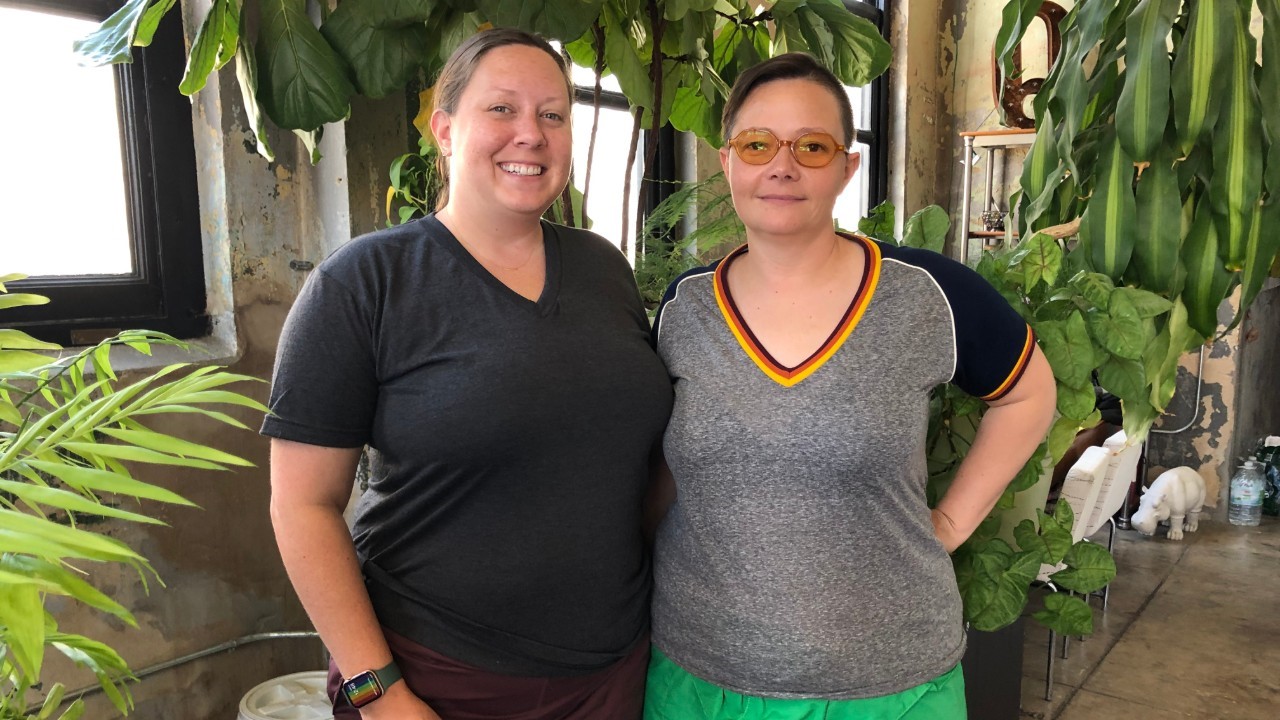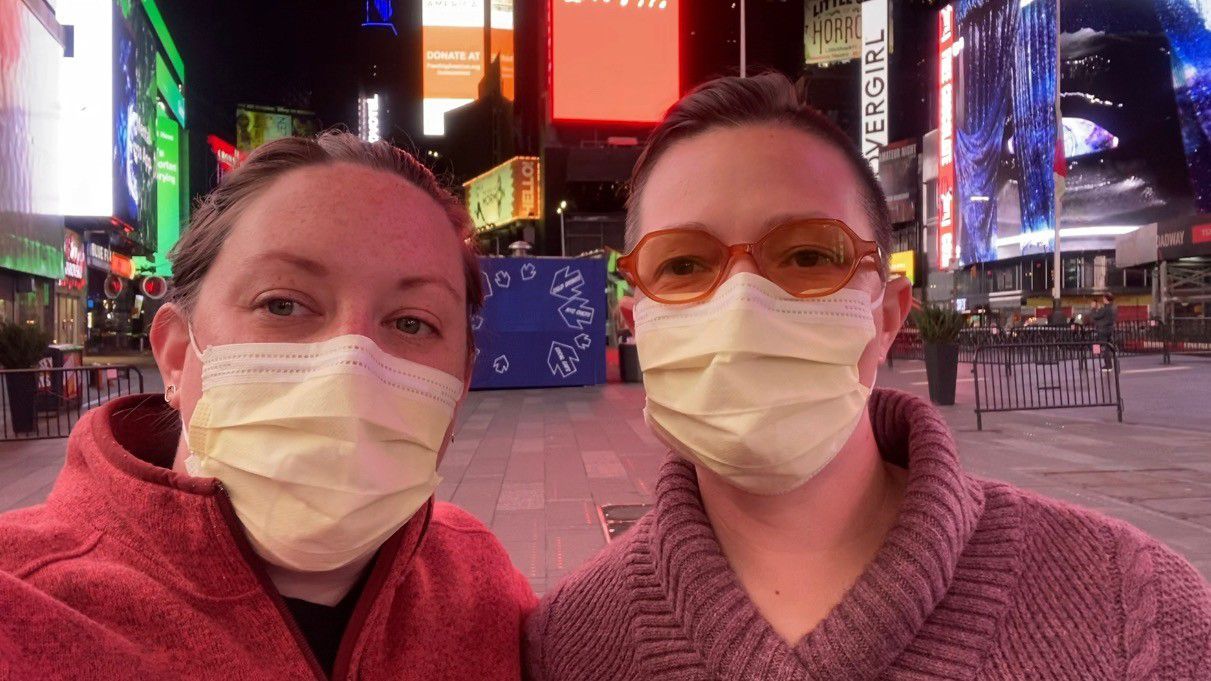FORT WORTH — At 6 a.m. on a Monday in March, Amanda Nelson and Annie Quasnitschka found themselves sitting in a conference room at Mount Sinai Hospital in Brooklyn. They had arrived in New York the night before. As they waited for the staff to greet them and the two other members of their team, the couple could hear rapid response alarms continually blaring in the distance. Neither of them was wearing a mask.
What You Need To Know
- Amanda Nelson and Annie Quasnitschka worked at Mount Sinai Hospital for six weeks during the early days of the country’s COVID-19 crisis
- Patients were dying almost every 20 minutes
- Three industrial refrigerator trucks remained parked outside of the hospital to store the dead
- The entire 212-bed hospital was turned into an ICU
The two Fort Worth-based nurse anesthetists had agreed to work on the front lines of the COVID-19 crisis – Quasnitschka hadn’t actually decided to go until the day before they boarded a plane, but she couldn’t bear the thought of her life partner confronting this unknown menace alone.
Staffers filed into the room dressed in layers of masks and other protective gear. As they shed their coverings, Nelson and Quasnitschka said they could see the deep trenches dug into the faces of their new co-workers, who had been wearing masks for hours on end. Their eyes, the two nurses said, were glossy from lack of sleep and shock.
“They’d been awake all night seeing people die,” Nelson said. “It can’t be exaggerated how much death was happening there.”
Every 20 minutes, the nurses said, someone was found dead, needing to be intubated, or requiring CPR. The entire hospital was converted into an intensive care unit. Ventilators dotted the landscape as hospital staff hurried from room to room to treat patients whose lives, in most cases, were already lost. Nurses and doctors were inventing treatments on the fly, experimenting in real time in the faint hope that some new combination of drugs or different tact would save a patient.
Family members of the sick weren’t allowed in the hospital to protect them from contracting the virus. Sick people who had checked in just a couple of days or even hours prior were dying alone and scared – in most cases after having watched their roommates foreshadow their gruesome fate. Three industrial refrigerator trucks remained parked outside of the hospital, so staff would have somewhere to store the dead.
In the early days of the novel Coronavirus, Brooklyn was hit especially hard. The virus found a fertile breeding ground of densely packed people who rely on public transportation. Many of the Midwood area residents – the Brooklyn neighborhood where Mount Sinai Hospital sits – are recently arrived, poor immigrants. Entire families are packed into small apartments. More than 219,000 cases have been confirmed in New York City alone, making it the single highest concentration of the virus in the world. Of the five boroughs, Brooklyn is home to the highest death rate from COVID-19 cases.
For Nelson and Quasnitschka, their six-week stint in the hospital was an emotional amalgam of hopelessness, trauma bonding, and character-testing work. They were dedicated, not just to the treatment of patients, but to the other nurses and staff who had already been dredged through a fresh hell every day for weeks.
“I probably personally laid hands on 250 dead people,” Nelson said. “And there were many I didn’t get to. And they’re all sick. The first week, I was like, ‘What the hell am I doing here,’” she continued. “‘These people are all dying, and I’m not helping anyone. I’m just exposing myself.’ But then I would think about it, and I just couldn’t abandon those people working there. They couldn’t leave. This was their home.”
A brindle-coated terrier mix, Samurai, lovingly stood guard at the converted warehouse in the South Main Village, where Nelson and Quasnitschka live. The walls and ceiling are concrete, with exposed air ducts zig-zagging throughout. Floor-to-ceiling windows bathe the room in natural light. The once-industrial area is now a hip, bustling epicenter for restaurants, bars, live music, and artists.
The two nurses sat on the other side of the room from a reporter during a recent interview.
"I just have to remind myself that it actually happened,” Quasnitschka said. “Talking about it reminds me that it’s something we lived through.”
Nelson and Quasnitschka worked for years at John Peter Smith hospital, and both pulled stints in the ICU – a baptism by fire in the local nursing world. JPS is one of the best-reputed trauma hospitals in the country. The worst accident and crime victims in the area are often rushed to the county hospital.
Dr. James Johnson, the nurse’s former boss at JPS, approached Nelson about helping a Manhattan hospital with their COVID-19 cases.
“I told him as long as they have all the PPE available for us that I would go,” Nelson said.
Quasnitschka was available because she, like so many CRNAs – nurses who specialize in anesthesiology – had been furloughed. The state had just barred elective surgeries (the first time), putting many anesthesiology specialists out of a job.
The doctor never entirely explained his motivation for asking them to help, and the two nurses didn’t ask. They figured their former colleague knew them, their work habits, and their level of expertise, and that’s why they received the call.
“We didn’t know what we were going into,” Quasnitschka said. “More than COVID, I was more scared to be without Amanda – for her to go by herself. I would rather go through COVID with her than separately.”
When the four Texans arrived in New York, Dr. Johnson heard that Mount Sinai in Brooklyn was teeming with COVID-19 patients and needed the help more than the hospital in Manhattan. The foursome was the first outside help to arrive at the struggling Brooklyn hospital.
What they saw shook them. The 212-bed hospital was converted entirely into an ICU. Nurses who had previously specialized in geriatrics or pediatrics were learning how to treat COVID-19 patients in real time. ICU nurses, who would normally care for just two patients, were being asked to oversee 10 or more.
“These nurses were amazing,” Quasnitschka said. “I don’t want anyone to think the patients weren’t getting the best care possible. This was a war zone. Everyone was doing the very best they could.”
Because of their expertise with airways, ventilators, and critical care, Nelson and Quasnitschka were assigned to the respiratory therapy team.
“Half the respiratory staff was sick with COVID,” Nelson said. “They were down people and had so many more patients than usual.”
In addition to caring for patients, the pair taught other nurses how to manage an acutely ill population.
“They didn’t know any of the medications or the machines,” Quasnitschka said. “The patients would need advance monitoring. We just started to teach [the other nurses], put lines in, set up the ventilator, and do education for the nurses who are also shell-shocked.”
By the time Nelson and Quasnitschka arrived in a patient’s room, their death was almost always a foregone conclusion. As members of the respiratory team, the pair would respond to the constant wailing of emergency codes.
“You just watch it, and you know exactly what’s happening but they don’t,” Quasnitschka said. “You just see the fear in their eyes and you can’t say anything. You know they are going to die, but you have to give them some hope.”
Though the patient load and death toll were grim, the nurses were complimentary of the hospital administrators, who were nimble and quick to adapt to a situation that went beyond most of the staff’s training. The staff, Nelson and Quasnitschka said, never complained – even as they watched their friends and neighbors die by the truckful.
“Most of the time, you just put one foot in front of the other and keep going,” Nelson said. “You don’t stop. Mostly, we knew we weren’t helping any of the patients because we knew they were all going to die.
“The people that were working there needed relief so badly,” she continued. “They’d been in the thick of it for so long. They were all working so hard, and it was so real to them. They all knew people who had died. They had co-workers, friends, and family. And they’re working. How could we stop working? It’s not even a consideration. You just keep going and going and going.”
Toward the end of the nurses’ six-week stint, the supervisor of the respiratory department at Mount Sinai asked Nelson and Quasnitschka if they’d like to stay another six weeks. The two agreed. They had grown loyal to the brave doctors, nurses, and staffers who were staring death in the face through protective masks a dozen times a day.
Just a week after agreeing to stay another month and a half, the company funding their visit told them they had to return home right away. The two nurses described it as though they were pulled out of combat. They never even had the chance to say goodbye to their co-workers.
“It’s just so weird to go through hell with those people and to not even get to tell them goodbye,” Quasnitschka said. “It sucked. And they were still pretty strapped for people when we left, but the patient load had diminished significantly.”
Though Nelson and Quasnitschka have become inured to trauma and death after years of experiencing it on the job, their stint at Mount Sinai has stuck with them.
“I didn’t have nightmares or have trouble sleeping,” Nelson said. “What I saw, though, it’s something that will stay with us forever. I think about it every day.”
Upon arriving home, the pair were greeted by news reports of unmasked protestors who were angry about businesses being forced to temporarily close. They watched as politicians turned something as simple as wearing a mask into political red meat. Bars, restaurants, salons, and other businesses re-opened, and many didn’t enforce any rules regarding masks or social distancing.
“They are crazy,” Quasnitschka said of people politicizing COVID-19. “It’s irresponsible. Those are the people that are going to make it take hold here. I think that people here are spread out enough to where it’s just going to smolder here for a long time.
“The virus doesn’t care how good of a person you are, what you look like, or who you vote for,” Quasnitschka continued. “There are no take-backs. Once it infects you, it’s going to do whatever it’s going to do.

Nurses Amanda Nelson and Annie Quasnitschka wanted to stay another six weeks at Mount Sinai Hospital, but were pulled out by their company.



